

Benchmarking the MVNx Community. Category:Telecommunications infrastructure. Category:Radio resource management. The Evolved Packet Core. Author: Frédéric Firmin, 3GPP MCC.
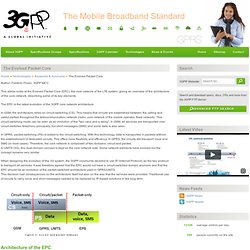
Signal Processing - Introduction to DSP - index. Wireless local loop. Wireless local loop (WLL), is a term for the use of a wireless communications link as the "last mile / first mile" connection for delivering plain old telephone service (POTS) or Internet access (marketed under the term "broadband") to telecommunications customers.
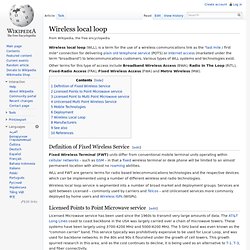
Various types of WLL systems and technologies exist. Other terms for this type of access include Broadband Wireless Access (BWA), Radio In The Loop (RITL), Fixed-Radio Access (FRA), Fixed Wireless Access (FWA) and Metro Wireless (MW). Definition of Fixed Wireless Service[edit] Fixed Wireless Terminal (FWT) units differ from conventional mobile terminal units operating within cellular networks – such as GSM – in that a fixed wireless terminal or desk phone will be limited to an almost permanent location with almost no roaming abilities.
WLL and FWT are generic terms for radio based telecommunications technologies and the respective devices which can be implemented using a number of different wireless and radio technologies. Your Daily Media. WiMAX. WiMAX (Worldwide Interoperability for Microwave Access) is a wireless communications standard designed to provide 30 to 40 megabit-per-second data rates,[1] with the 2011 update providing up to 1 Gbit/s[1] for fixed stations.
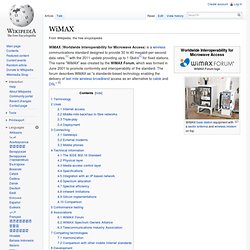
The name "WiMAX" was created by the WiMAX Forum, which was formed in June 2001 to promote conformity and interoperability of the standard. The forum describes WiMAX as "a standards-based technology enabling the delivery of last mile wireless broadband access as an alternative to cable and DSL".[2] Terminology[edit] WiMAX refers to interoperable implementations of the IEEE 802.16 family of wireless-networks standards ratified by the WiMAX Forum.
(Similarly, Wi-Fi, refers to interoperable implementations of the IEEE 802.11 Wireless LAN standards certified by the Wi-Fi Alliance.) The original IEEE 802.16 standard (now called "Fixed WiMAX") was published in 2001. Beam tilt. Beam tilt is used in radio to aim the main lobe of the vertical plane radiation pattern of an antenna below (or above) the horizontal plane.
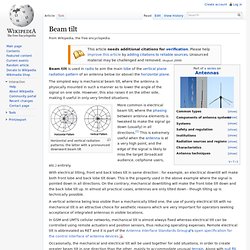
The simplest way is mechanical beam tilt, where the antenna is physically mounted in such a manner as to lower the angle of the signal on one side. However, this also raises it on the other side, making it useful in only very limited situations. Horizontal and vertical radiation patterns, the latter with a pronounced downward beam tilt With electrical tilting, front and back lobes tilt in same direction : for example, an electrical downtilt will make both front lobe and back lobe tilt down. Signal Processing - Introduction to DSP - index.
Network Concepts. Multiprotocol Label Switching. Multiprotocol Label Switching (MPLS) is a mechanism in high-performance telecommunications networks that directs data from one network node to the next based on short path labels rather than long network addresses, avoiding complex lookups in a routing table.
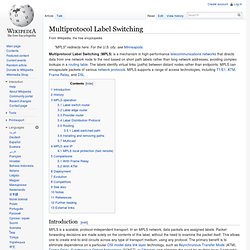
The labels identify virtual links (paths) between distant nodes rather than endpoints. MPLS can encapsulate packets of various network protocols. MPLS supports a range of access technologies, including T1/E1, ATM, Frame Relay, and DSL. Introduction[edit] MPLS is a scalable, protocol-independent transport. In particular, MPLS dispenses with the cell-switching and signaling-protocol baggage of ATM.
At the same time, MPLS attempts to preserve the traffic engineering and out-of-band control that made Frame Relay and ATM attractive for deploying large-scale networks. History[edit] MPLS operation[edit] A 20-bit label value. Next-generation network. Description[edit] According to ITU-T, the definition is: From a practical perspective, NGN involves three main architectural changes that need to be looked at separately: In the core network, NGN implies a consolidation of several (dedicated or overlay) transport networks each historically built for a different service into one core transport network (often based on IP and Ethernet).
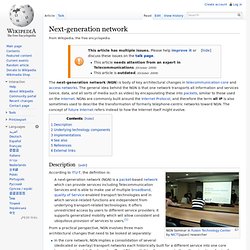
In an NGN, there is a more defined separation between the transport (connectivity) portion of the network and the services that run on top of that transport. This means that whenever a provider wants to enable a new service, they can do so by defining it directly at the service layer without considering the transport layer – i.e. services are independent of transport details. Underlying technology components[edit] Next-generation networks are based on Internet technologies including Internet Protocol (IP) and multiprotocol label switching (MPLS). One may quite often find the term Gatekeeper in NGN literature. Telecommunications network. Example of how nodes may be interconnected with links to form a telecommunications network.
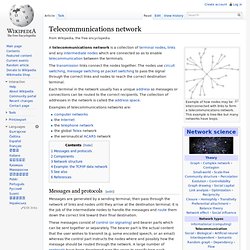
This example is tree-like but many networks have loops. Each terminal in the network usually has a unique address so messages or connections can be routed to the correct recipients. The collection of addresses in the network is called the address space. Examples of telecommunications networks are: Messages and protocols[edit] Messages are generated by a sending terminal, then pass through the network of links and nodes until they arrive at the destination terminal. Components[edit] All telecommunication networks are made up of five basic components that are present in each network environment regardless of type or use.